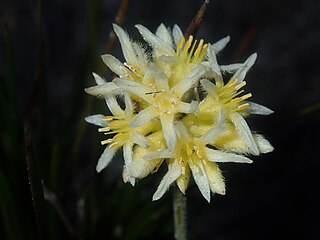
Conostylis setigera, commonly known as bristly cottonhead, is a rhizomatous, tufted perennial, grass-like plant or herb in the family Haemodoraceae and is endemic to the south-west of Western Australia.

Conostylis bracteata is a tufted perennial plant in the family Haemodoraceae and is endemic to the south-west of Western Australia. It is a rhizomatous, tufted, perennial, grass-like plant or herb with flat leaves and yellow, hairy, tubular flowers.

Conostylis canteriata is a rhizomatous, tufted perennial, grass-like plant or herb in the family Haemodoraceae and is endemic to the south-west of Western Australia. It has stilted roots, flat leaves, and pale lemon-yellow tubular flowers.

Conostylis caricina is a flowering plant in the family Haemodoraceae and is endemic to the south-west of Western Australia. It is a rhizomatous, tufted perennial, grass-like plant or herb with flat leaves and heads of 6 to 8 creamy-yellow flowers.

Conostylis crassinerva is a rhizomatous, tufted perennial, grass-like plant or herb in the family Haemodoraceae and is endemic to the south-west of Western Australia. It has flat leaves and yellow tubular flowers that turn reddish as they age.

Conostylis festucacea is a rhizomatous, tufted or proliferous perennial, grass-like plant or herb in the family Haemodoraceae, and is endemic to the south-west of Western Australia. It has cylindrical or flat leaves and yellow flowers.

Conostylis hiemalis is a rhizomatous, tufted perennial, grass-like plant or herb in the family Haemodoraceae and is endemic to the south-west of Western Australia. It has flat leaves, usually with woolly grey hairs at the base, and pale yellow to cream-coloured, tubular flowers.
Conostylis latens is a rhizomatous, tufted perennial, grass-like plant or herb in the family Haemodoraceae and is endemic to the south-west of Western Australia. It has flat, green, usually hairy leaves, and greenish-yellow, tubular flowers.
Conostylis lepidospermoides, commonly known as sedge conostylis, is a rhizomatous, tufted perennial, grass-like plant or herb in the family Haemodoraceae and is endemic to the south-west of Western Australia. It has flat, yellowish-green, glabrous leaves, and lemon-yellow, tubular flowers.
Conostylis micrantha, commonly known as small-flowered conostylis, is a rhizomatous, tufted perennial, grass-like plant or herb in the family Haemodoraceae and is endemic to the south-west of Western Australia. It has leaves that are round in cross-section and have bristles or hairs on the lower edges, and pale yellowish cream, tubular flowers.
Conostylis neocymosa is a rhizomatous, tufted perennial, grass-like plant or herb in the family Haemodoraceae and is endemic to the south-west of Western Australia. It has flat, green leaves with bristles on the edges, and yellow, tubular flowers.
Conostylis pauciflora, commonly known as Dawesville conostylis, is a rhizomatous, stoloniferous, perennial, grass-like plant or herb in the family Haemodoraceae and is endemic to the south-west of Western Australia. It has flat, green leaves with bristles on the edges, and relatively few tubular flowers.
Conostylis petrophiloides is a rhizomatous, tufted perennial, grass-like plant or herb in the family Haemodoraceae and is endemic to the south-west of Western Australia. It has flat, glabrous leaves, and yellowish-cream coloured, tubular flowers.

Conostylis phathyrantha is a rhizomatous, tufted perennial, grass-like plant or herb in the family Haemodoraceae and is endemic to the south of Western Australia. It has flat, glabrous leaves, and yellow, tubular flowers.

Conostylis prolifera, commonly known as mat cottonheads, is a rhizomatous, tufted, stoloniferous, perennial, grass-like plant or herb in the family Haemodoraceae and is endemic to the south-west of Western Australia. It has flat, glabrous leaves, and yellow and cream-coloured, tubular flowers.
Conostylis resinosa is a rhizomatous, tufted perennial, grass-like plant or herb in the family Haemodoraceae and is endemic to the south-west of Western Australia. It has flat, shiny leaves, yellow, tubular flowers and is similar to C. aurea.

Conostylis robusta is a rhizomatous, tufted, stoloniferous, perennial, grass-like plant or herb in the family Haemodoraceae and is endemic to the south-west of Western Australia. It has flat, green leaves with bristles on the edges, and heads of yellow flowers on a relatively long flowering stem.
Conostylis rogeri is a rhizomatous, tufted perennial, grass-like plant or herb in the family Haemodoraceae and is endemic to a small area in the south-west of Western Australia. It has small tufts, flat leaves, and a single pale yellow, tubular flower.

Conostylis seminuda is a rhizomatous, tufted perennial, grass-like plant or herb in the family Haemodoraceae and is endemic to a small area in the south-west of Western Australia. It has flat leaves and golden yellow, tubular flowers.

Conostylis seorsiflora is a rhizomatous, tufted perennial, grass-like plant or herb in the family Haemodoraceae and is endemic to the south of Western Australia. It has flat leaves and yellow, tubular flowers.












